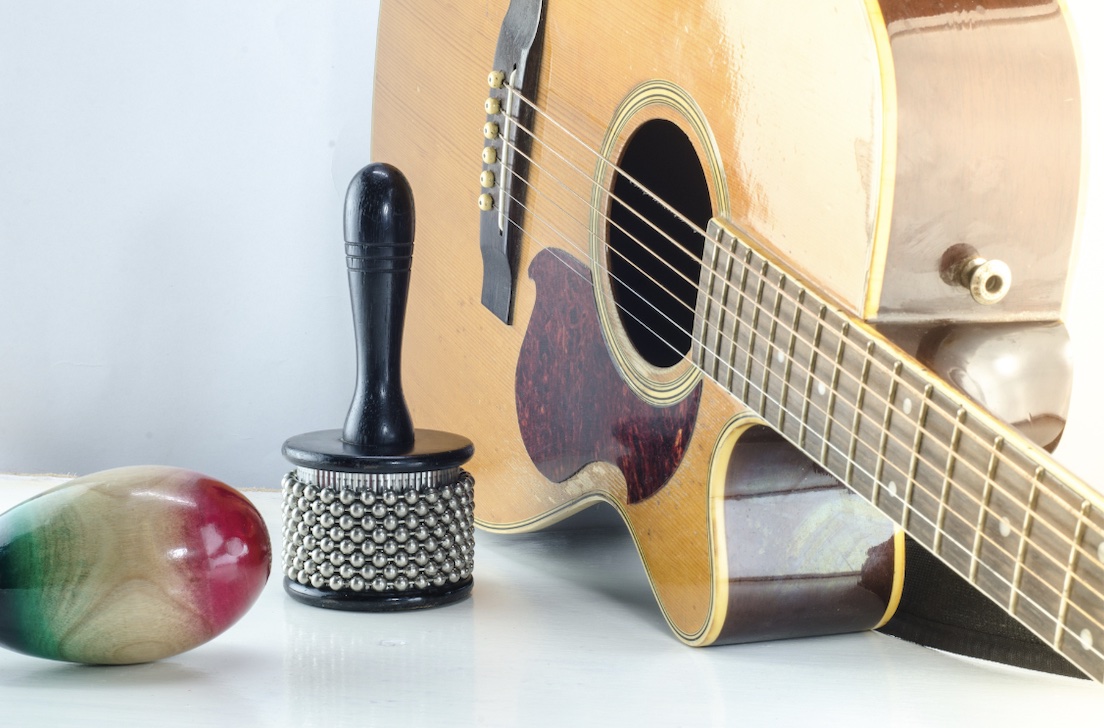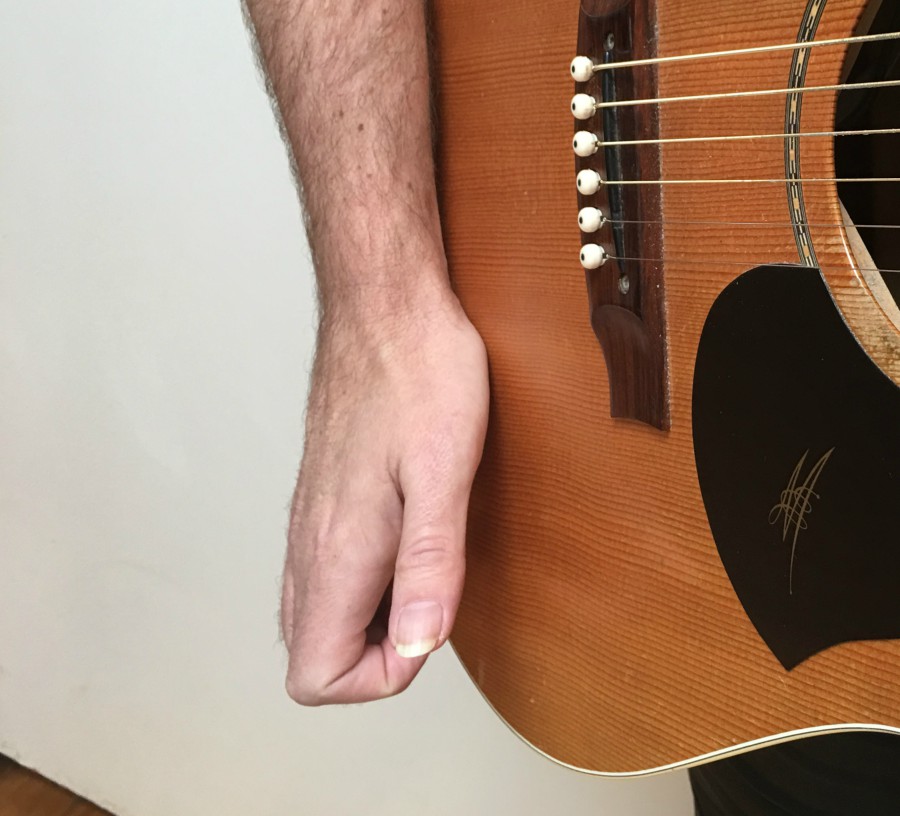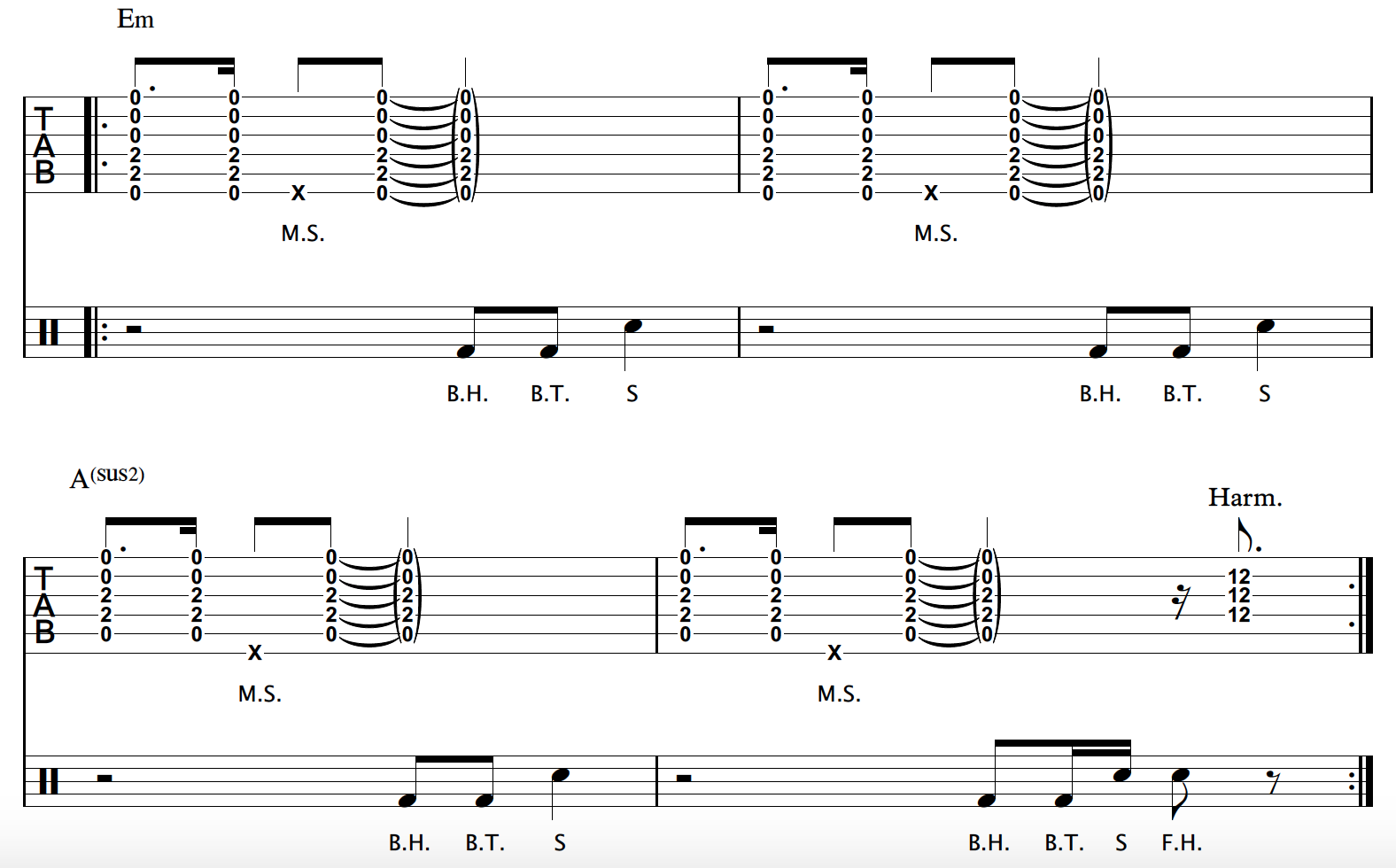How To Play Percussive Guitar
By Simon Candy
 Unless you have been living under a rock, you will no doubt have been exposed to percussive guitar playing. It has become an increasingly popular style of playing acoustic guitar over the years, and while it’s not to everyone’s tastes, a little ability in this area of playing can go a long way.
Unless you have been living under a rock, you will no doubt have been exposed to percussive guitar playing. It has become an increasingly popular style of playing acoustic guitar over the years, and while it’s not to everyone’s tastes, a little ability in this area of playing can go a long way.
In today's article, you learn some simple percussive guitar techniques you can get into your playing right away. After learning these techniques you will then combine them to create some cool sounding beats and grooves on the body of your guitar.
We will also integrate these beats and grooves into a chord progression, in which you will play both the percussive part as well as the chords, all at the same time!
The video below will reinforce and further train the concepts taught in this article, so bookmark it to check out after working through this lesson:
Percussive Guitar Techniques
Before we start, it's crucial to analyze each percussive guitar technique we'll be discussing today separately.
It's essential to do this to understand the importance of each one.
You can't expect to play a rhythm or a beat that consists of multiple percussive elements while simultaneously playing a chord progression on your guitar without breaking things down first.
• Muted Slap (M.S.)
 This first percussive technique, known as a muted slap, is going to be achieved by slapping your strings, rather than the body of your acoustic guitar. You do this by simply using the side of your picking hand thumb to slap the lower strings of your guitar (indicated with an “x” in the tablature.)
This first percussive technique, known as a muted slap, is going to be achieved by slapping your strings, rather than the body of your acoustic guitar. You do this by simply using the side of your picking hand thumb to slap the lower strings of your guitar (indicated with an “x” in the tablature.)

Even though the “x” only appears on the lower string in the tab, you will end up hitting several strings. This is fine. It is the sound this makes that we are after, not how many strings we do or don't hit.
Listen carefully to the example above and check the picture for reference.
Things to keep in mind:
• A relaxed hand, wrist, and arm
• The movement is generated by a flick of your wrist, so make sure you aren’t trying to hammer down on the strings generating the movement from your elbow only
• Bass Drum Hit With Thumb (B.T.)
 We are going to be looking at two kinds of bass drum hits. The first is sounded once again by using the thumb of your picking hand. It is the same motion explained for the muted slap above, only here you are slapping the lower area of the soundboard on the front of your guitar.
We are going to be looking at two kinds of bass drum hits. The first is sounded once again by using the thumb of your picking hand. It is the same motion explained for the muted slap above, only here you are slapping the lower area of the soundboard on the front of your guitar.
This percussive technique is notated in the first space of the musical stave and referenced with B.T. (bass drum hit with the thumb)

Be sure to check the picture for reference.
Things to keep in mind:
• A relaxed hand, wrist, and arm
• Flicking your wrist to generate the movement as you did with the muted slap
• Bass Drum Hit With Heel Of Hand (B.H.)
 The second of the bass drum hits will involve the heel of your picking hand hitting the lower area of the soundboard of your guitar. This will create more of a “thud” type sound compared to the bass drum hit with your thumb.
The second of the bass drum hits will involve the heel of your picking hand hitting the lower area of the soundboard of your guitar. This will create more of a “thud” type sound compared to the bass drum hit with your thumb.
This percussive technique is also notated in the first space of the musical stave, like the first one, but referenced with B.H. (bass drum hit with heel of your hand)

Things to keep in mind:
• Connecting the heel of your hand with the body of your guitar
• Not damaging your guitar by hitting it too hard
• Snare Hit (S)
 For a great snare/rim shot sound, tap/rap your fingers on the side of the body of your guitar. It’s best to use two fingers when doing this. Personally I like to use my ring and pinky fingers, but you might like to use a different combination.
For a great snare/rim shot sound, tap/rap your fingers on the side of the body of your guitar. It’s best to use two fingers when doing this. Personally I like to use my ring and pinky fingers, but you might like to use a different combination.
This percussive technique is notated in the third space of the musical stave and referenced with “S” (snare)

Be sure to listen to the audio example and refer to the picture to achieve this high-pitched popping sound, similar to a snare or rimshot.
Things to keep in mind:
• As always a nice and relaxed hand, wrist, and arm
• Aim to connect with the base of the two fingers you are using to rap/tap the side of the body of your guitar, rather than higher up the fingers. This will give you the high end popping sound you are after
• Again, this technique is generated by a flick of the wrist
• Fret hand Hit (F.H.)
 Another snare type sound can be achieved by using your fretting hand to tap the side of your guitar just below the neck. You may also tap the front of the guitar just below the fretboard instead, if you prefer.
Another snare type sound can be achieved by using your fretting hand to tap the side of your guitar just below the neck. You may also tap the front of the guitar just below the fretboard instead, if you prefer.
This percussive technique is also notated in the third space of the musical stave and referenced with “F.H.” (fret hand snare hit)

Again listen to the example above as well as check the relevant picture for reference.
Things to keep in mind:
• Dare I say, a relaxed hand, wrist, and arm :)
• Getting your fretting hand out in front of the guitar, no thumb behind the neck, executing the technique, and then getting your hand back in position ready to continue playing
• The Slap
An additional percussive skill is the slap technique. This is when you sound notes by slapping them with the side of your thumb as opposed to picking or plucking them.
This approach brings a very cool groove to your playing.
You can learn all about this technique in the video below:
Combining Percussive Techniques
The next step is to combine these percussive techniques to create beats and grooves on your guitar.
Here are some possibilities:
• Percussive Guitar Beat 1

This is a simple rock groove with bass drum hits on 1 and 3 and snare hits on 2 and 4
• Percussive Guitar Beat 2
Here is another beat/groove combining some of our percussive techniques. Here I am applying bass drum hits (B.H.) on beats 1 and 3, a snare/rimshot (S) on 2 and 4, as well as thumb hits on the body of the guitar (B.T.) on the offbeats of 1 and 3:

• Percussive Guitar Beat 3
This third beat is the same as the previous one, only with a fret hand (F.H.) hit added on the offbeats of 2 and 4:

Integrating Percussive Techniques
Now it’s time to go for it!
This example will include not just the percussive techniques you have learned, but a two chord vamp to integrate them with.
Here it is:

Things To Focus On:
 • Play SLOWLY and break things up into smaller pieces to work on. You MUST go slow enough so that you can ENGAGE your brain with EVERY move you make
• Play SLOWLY and break things up into smaller pieces to work on. You MUST go slow enough so that you can ENGAGE your brain with EVERY move you make
• Isolate the strumming and string slapping part from the body percussion hits. Working on both parts separately is a much more effective way to get this down
• Pay particular attention to the second half of the last bar. There are four body percussion hits to be played together with a harmonic slap at the 12th fret. The harmonic slap is achieved by slapping the middle finger of your picking hand over the top of the 12th fret, producing a chime-like sound (refer to the picture for guidance, and ensure that your middle finger bounces off the strings instead of resting on the fretboard).
• Keep your picking hand relaxed when performing both string slapping techniques and body percussion hits. The movement is generated from the wrist